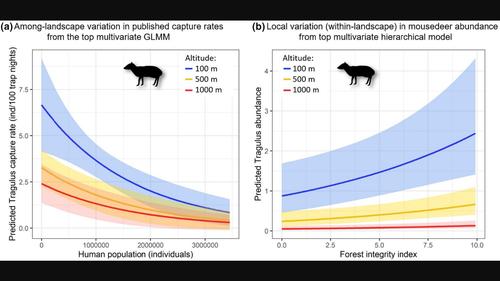当前位置:
X-MOL 学术
›
Austral Ecol.
›
论文详情
Our official English website, www.x-mol.net, welcomes your feedback! (Note: you will need to create a separate account there.)
A multi-scale synthesis of mousedeer habitat associations in Southeast Asia reveals declining abundance but few extirpations in fragments and edges
Austral Ecology ( IF 1.5 ) Pub Date : 2023-12-22 , DOI: 10.1111/aec.13470 Calebe P. Mendes 1, 2 , Xiaohan Liu 2 , Zachary Amir 2 , Jonathan H. Moore 3, 4 , Matthew Scott Luskin 2, 5
Austral Ecology ( IF 1.5 ) Pub Date : 2023-12-22 , DOI: 10.1111/aec.13470 Calebe P. Mendes 1, 2 , Xiaohan Liu 2 , Zachary Amir 2 , Jonathan H. Moore 3, 4 , Matthew Scott Luskin 2, 5
Affiliation

|
Habitat loss and fragmentation profoundly impact Southeast Asian rainforest biodiversity and ecosystem functioning. While many larger herbivores are hunted and area-demanding apex predators are lost from degraded forests (logged forests, forest fragments and forest edges), smaller herbivore species may be comparatively resilient or even benefit from a release from competition and predation in degraded forests. Mousedeer (or chevrotains) in the Tragulus genus are some of the world's smallest ungulates (1.5–4.5 kg) and are widespread in Southeast Asia. We evaluated mousedeer habitat associations at three spatial scales. At the regional scale, presence-only species distribution modelling suggested mousedeer are negatively associated with aridity and elevation. At the landscape scale, variation capture rates among 186 published camera trapping studies suggested mousedeer are negatively associated with forest degradation and elevation. At the local scale (within landscapes), mousedeer abundance sampled with 1218 cameras at 10 landscapes and analysed with hierarchical abundance modelling suggested mousedeer are negatively associated with humans and elevation. Mousedeer diel activity patterns shifted towards increased nocturnality in degraded forests, possibly to avoid interactions with diurnal humans. Taken together, mousedeer prefer wet lowland forests and they persist – but decline – in degraded habitats and near humans. One exception was degraded forest fragments of Singapore where mousedeer are very abundant, likely due to the absence of hunting and predators. Our results emphasize that small herbivores persisting in fragmented rainforests decline relative to intact forests and thus are unlikely to be experiencing significant release from competition or predation. They also differ from small omnivorous generalists who experience beneficial foraging opportunities at edges. In degraded forests where larger wildlife has been lost, even low densities of small herbivores may perpetuate important ecological interactions such as herbivory, seed dispersal, or as prey for remaining predators.
中文翻译:

东南亚鼷鹿栖息地协会的多尺度综合显示,其数量正在下降,但碎片和边缘的灭绝却很少
栖息地丧失和破碎化深刻影响东南亚雨林的生物多样性和生态系统功能。虽然许多较大的食草动物被猎杀,并且需要面积的顶级捕食者从退化的森林(砍伐的森林、森林碎片和森林边缘)中消失,但较小的食草动物物种可能相对具有弹性,甚至受益于退化森林中竞争和捕食的释放。鼷属的鼷鹿(或鼷鹿)是世界上最小的有蹄类动物(1.5-4.5 公斤),广泛分布于东南亚。我们在三个空间尺度上评估了鼷鹿栖息地关联。在区域尺度上,仅存在的物种分布模型表明鼷鹿与干旱和海拔呈负相关。在景观尺度上,186 项已发表的相机捕捉研究中的变化捕获率表明鼷鹿与森林退化和海拔呈负相关。在局部尺度(景观内),用 1218 个摄像机在 10 个景观中对鼷鹿丰度进行了采样,并通过分层丰度模型进行了分析,表明鼷鹿与人类和海拔呈负相关。在退化的森林中,鼷鹿的昼夜活动模式转向增加夜间活动,可能是为了避免与白天活动的人类相互作用。总的来说,鼷鹿更喜欢潮湿的低地森林,它们在退化的栖息地和人类附近持续存在,但数量不断减少。一个例外是新加坡退化的森林碎片,那里的鼷鹿数量非常丰富,这可能是由于缺乏狩猎和掠食者。我们的结果强调,相对于完整的森林,在支离破碎的雨林中持续存在的小型食草动物数量减少,因此不太可能经历竞争或捕食的显着释放。它们也不同于小型杂食性多面手,后者在边缘体验到有益的觅食机会。在大型野生动物消失的退化森林中,即使是低密度的小型食草动物也可能使重要的生态相互作用永久存在,例如食草、种子传播或成为剩余捕食者的猎物。
更新日期:2023-12-25
中文翻译:

东南亚鼷鹿栖息地协会的多尺度综合显示,其数量正在下降,但碎片和边缘的灭绝却很少
栖息地丧失和破碎化深刻影响东南亚雨林的生物多样性和生态系统功能。虽然许多较大的食草动物被猎杀,并且需要面积的顶级捕食者从退化的森林(砍伐的森林、森林碎片和森林边缘)中消失,但较小的食草动物物种可能相对具有弹性,甚至受益于退化森林中竞争和捕食的释放。鼷属的鼷鹿(或鼷鹿)是世界上最小的有蹄类动物(1.5-4.5 公斤),广泛分布于东南亚。我们在三个空间尺度上评估了鼷鹿栖息地关联。在区域尺度上,仅存在的物种分布模型表明鼷鹿与干旱和海拔呈负相关。在景观尺度上,186 项已发表的相机捕捉研究中的变化捕获率表明鼷鹿与森林退化和海拔呈负相关。在局部尺度(景观内),用 1218 个摄像机在 10 个景观中对鼷鹿丰度进行了采样,并通过分层丰度模型进行了分析,表明鼷鹿与人类和海拔呈负相关。在退化的森林中,鼷鹿的昼夜活动模式转向增加夜间活动,可能是为了避免与白天活动的人类相互作用。总的来说,鼷鹿更喜欢潮湿的低地森林,它们在退化的栖息地和人类附近持续存在,但数量不断减少。一个例外是新加坡退化的森林碎片,那里的鼷鹿数量非常丰富,这可能是由于缺乏狩猎和掠食者。我们的结果强调,相对于完整的森林,在支离破碎的雨林中持续存在的小型食草动物数量减少,因此不太可能经历竞争或捕食的显着释放。它们也不同于小型杂食性多面手,后者在边缘体验到有益的觅食机会。在大型野生动物消失的退化森林中,即使是低密度的小型食草动物也可能使重要的生态相互作用永久存在,例如食草、种子传播或成为剩余捕食者的猎物。



























 京公网安备 11010802027423号
京公网安备 11010802027423号